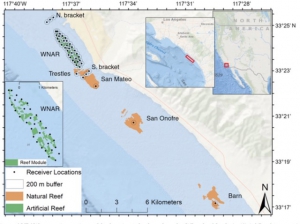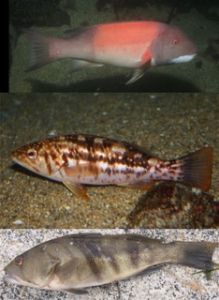Acoustic Telemetry Analysis of California Gamefish Reveals the Functional Performance of the Wheeler North Artificial Reef
By Chelsea Black, SRC MS Student
Submerged structures such as ships, steel frames, or boulders placed on the seafloor deliberately to mimic attributes of a natural habitat are known as artificial reefs (ARs). Since the development of the National Fishing Enhancement Act of 1984, most AR construction in the United States has been focused on enhancing fishery resources and opportunities (Logan & Lowe 2018). These ARs provide new habitat for both fish and benthic organisms to colonize, which increases food resources and overall fish biomass. However, to establish reef productivity for mobile species it is pertinent to know when and for how long species are resident to a reef, which has historically been overlooked by previous AR studies.
The largest constructed rock reef in the US, the Wheeler North Artificial Reef (WNAR) off the coast of San Clemente in the Southern California Bight, was built by the Southern California Edison Company (SCE) as mitigation for the loss of the San Onofre Kelp Bed after discharged cooling water from a nuclear generating station resulted in restricted giant kelp growth and subsequently the loss of species diversity (Figure 1). For SCE to receive mitigation credit, WNAR must either meet or exceed the abiotic and biotic performance standards relative to community performance from two nearby natural reefs, the San Mateo Kelp Bed (SMK) and the Barn Kelp Bed (BK).

Figure 1. Construction of the WNAR [Source: www.ucsb.edu].

Figure 2. Locations of acoustic receivers and neighboring natural reefs [Logan & Lowe 2018].

Figure 3. From top to bottom: California sheephead, kelp bass, and barred sand bass [Source: Wikimedia Commons].
After analyzing movement patterns of the tagged fish across WNAR, SMK and BK, this study suggests that during favorable conditions fish were highly resident to WNAR and demonstrate that it is currently functioning similar to the surrounding natural reef habitats, effectively reaching the set performance standards. In addition, the results reveal that future AR management plans in California would be most successful when implementing structures that are ideal for giant kelp growth to aid in increased species diversity in abundance by providing an ideal habitat for important species.
Works Cited
Logan, R. K., & Lowe, C. G. (2018). Residency and inter-reef connectivity of three gamefishes between natural reefs and a large mitigation artificial reef. Marine Ecology Progress Series, 593, 111-126.
Martin CJ, Lowe CG (2010) Assemblage structure of fish at offshore petroleum platforms on the San Pedro Shelf of southern California. Mar Coast Fish 2:180−194.
